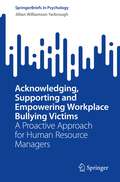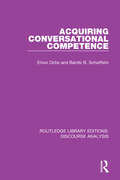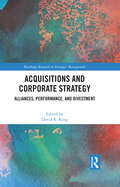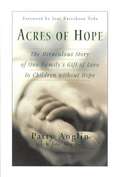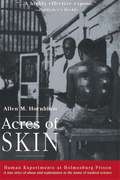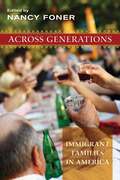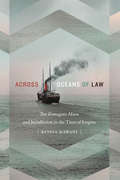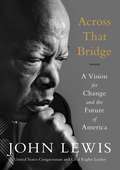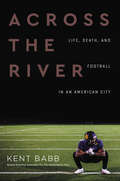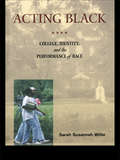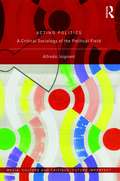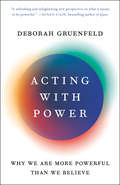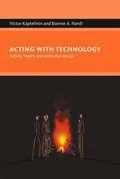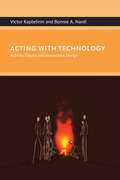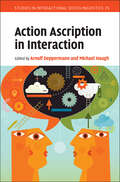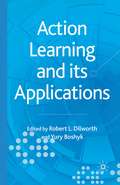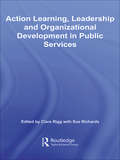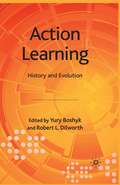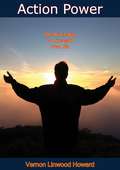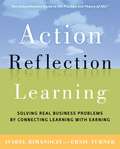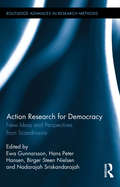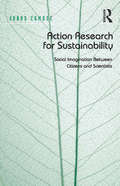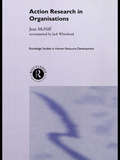- Table View
- List View
Acknowledging, Supporting and Empowering Workplace Bullying Victims: A Proactive Approach for Human Resource Managers (SpringerBriefs in Psychology)
by Jillian Williamson YarbroughThis book identifies potential support for workplace victimization through an examination of employee’s needs and needs-based motivation theories. Based on contemporary research in victimology and long-standing needs-based theories, it outlines how workplace bullying victims’ needs can be identified and how victims of workplace harassment can be empowered through the development and attainment of their unmet needs.The volume will be of interest to practitioners at the intersection of organizational and forensic psychology practitioners examining lacking needs as motivators for workplace bullying or harassment.
Acquired Tastes
by Peter MayleInternationally bestselling author of A Year in Provence, Mayle comes out with a new bestseller about the true pleasure of fine living.
Acquiring conversational competence (RLE: Discourse Analysis)
by Elinor Ochs Bambi B. SchieffelinFirst published in 1983, this book represents a substantial body of detailed research on children’s language and communication, and more generally on the nature of interactive spoken discourse. It looks at areas of competence often examined in young children’s speech have that have not been described for adults — leading to insights not only in the character of adult conversation but also the process of acquiring this competence. The authors set forward strategies for conversing at different stage of life, while also relating these strategies to, and formulating hypotheses concerning, the dynamics of language variation and change.
Acquisition and Analysis of Terrestrial Gravity Data
by Leland Timothy Long Ronald Douglas KaufmannGravity surveys have a huge range of applications, indicating density variations in the subsurface and identifying man-made structures, local changes of rock type or even deep-seated structures at the crust/mantle boundary. This important one-stop book combines an introductory manual of practical procedures with a full explanation of analysis techniques, enabling students, geophysicists, geologists and engineers to understand the methodology, applications and limitations of a gravity survey. Filled with examples from a wide variety of acquisition problems, the book instructs students in avoiding common mistakes and misconceptions. It explores the increasing near-surface geophysical applications being opened up by improvements in instrumentation and provides more advance-level material as a useful introduction to potential theory. This is a key text for graduate students of geophysics and for professionals using gravity surveys, from civil engineers and archaeologists to oil and mineral prospectors and geophysicists seeking to learn more about the Earth's deep interior.
Acquisitions and Corporate Strategy: Alliances, Performance, and Divestment (Routledge Research in Strategic Management)
by David R. KingCorporate restructuring (acquisitions, alliances and divestment) is a visible form of corporate strategy. For example, firm investments in buying and selling assets exceed the gross domestic product of the majority of nations. Most research in this area examines acquisitions, but informing practice is limited by examining acquisitions in isolation or using a narrow focus. For example, a lingering problem is that average acquisition performance is consistently around zero, suggesting a need to identify practically relevant relationships. In addressing this need, research on three fundamental questions is covered: 1) How do acquisitions relate to other corporate strategy options?; 2) What helps to predict acquisition performance?; and 3) What are persistent acquisition research issues? The first question is intended to overcome a research limitation that acquisitions are often examined independent of other corporate strategies, including internal development, alliances, and divestment. The second question addresses novel relationships associated with the primary focus of acquisition research in examining what drives acquisition performance. The third question reflects on the underlying complexity of the phenomenon that makes it a challenge to identify what drives acquisition performance. Overall, the intent of presenting ideas on these fundamental questions is to illustrate promising areas for future research. This book presents the latest state of knowledge on the topic and will be of interest to researchers, academics, and advanced students in the fields of strategic management, international business, and organizational studies.
Acres of Hope: The Miraculous Story of One Family's Gift of Love to Children Without Hope
by Joe Musser Patty AnglinBack Cover: Over the past several years, Patty and Harold Anglin have adopted eight children with special needs, adding to their already large family of seven biological children. Their adopted children range in age from six months to fifteen years. They come from all over the world, from as far away as Nigeria and India. They are children who would have had no hope in this world if Patty and Harold had not opened their hearts and given them a home bursting with love and acceptance. Many people have asked Patty and Harold why they have adopted so many children with special needs. Their answer is simple, "There is a need!" Years ago, God gave them the verse, "And whoever receives one little child like this in My name receives Me" (Matthew 18:5). God has brought each miracle child into the Anglin home in a special way. They simply responded to the call. Patty says, "Our wish is that every innocent child will come to know and feel the love and security of a family. We believe if you are faithful and obedient servants of God, He will supply all your needs. We know this to be true; He has never let us down!"
Acres of Skin: Human Experiments at Holmesburg Prison
by Allen M. HornblumAt a time of increased interest and renewed shock over the Tuskegee syphilis experiments, Acres of Skin sheds light on yet another dark episode of American medical history. In this disturbing expose, Allen M. Hornblum tells the story of Philadelphia's Holmesburg Prison.
Across Generations: Immigrant Families in America
by Nancy FonerImmigrants and their American-born children represent about one quarter of the United States population. Drawing on rich, in-depth ethnographic research, the fascinating case studies in Across Generations examine the intricacies of relations between the generations in a broad range of immigrant groups—from Latin America, Asia, the Caribbean, and Africa—and give a sense of what everyday life is like in immigrant families.Moving beyond the cliché of the children of immigrants engaging in pitched battles against tradition-bound parents from the old country, these vivid essays offer a nuanced view that brings out the ties that bind the generations as well as the tensions that divide them. Tackling key issues like parental discipline, marriage choices, educational and occupational expectations, legal status, and transnational family ties, Across Generations brings crucial insights to our understanding of the United States as a nation of immigrants.Contributors: Leisy Abrego, JoAnn D’Alisera, Joanna Dreby, Yen Le Espiritu, Greta Gilbertson, Nazli Kibria, Cecilia Menjívar, Jennifer E. Sykes, Mary C. Waters, and Min Zhou.
Across Oceans of Law: The Komagata Maru and Jurisdiction in the Time of Empire (Global and Insurgent Legalities)
by Renisa MawaniIn 1914 the British-built and Japanese-owned steamship Komagata Maru left Hong Kong for Vancouver carrying 376 Punjabi migrants. Chartered by railway contractor and purported rubber planter Gurdit Singh, the ship and its passengers were denied entry into Canada and two months later were deported to Calcutta. In Across Oceans of Law Renisa Mawani retells this well-known story of the Komagata Maru. Drawing on "oceans as method"—a mode of thinking and writing that repositions land and sea—Mawani examines the historical and conceptual stakes of situating histories of Indian migration within maritime worlds. Through close readings of the ship, the manifest, the trial, and the anticolonial writings of Singh and others, Mawani argues that the Komagata Maru's landing raised urgent questions regarding the jurisdictional tensions between the common law and admiralty law, and, ultimately, the legal status of the sea. By following the movements of a single ship and bringing oceans into sharper view, Mawani traces British imperial power through racial, temporal, and legal contests and offers a novel method of writing colonial legal history.
Across That Bridge: Life Lessons and a Vision for Change
by John LewisWinner of the NAACP Image Award for Outstanding Literary Work/Biography -- in paperback for the first time.In turbulent times Americans look to the Civil Rights Movement as the apotheosis of political expression. As we confront questions of social inequality there's no better time to revisit the lessons of the '60s and no better leader to learn from than Congressman John Lewis.In Across That Bridge, Congressman Lewis draws from his experience as a leader of the Civil Rights Movement to offer timeless guidance to anyone seeking to live virtuously and transform the world. His wisdom, poignant recollections, and powerful ideas will inspire a new generation to usher in a freer, more peaceful society. The Civil Rights Movement gave rise to the protest culture we know today, and the experiences of leaders like Congressman Lewis have never been more relevant. Now featuring an updated introduction from the author addressing the current administration, Across that Bridge offers a strong and moral voice to guide our nation through an era of great uncertainty."The most important lesson I have learned in the fifty years I have spent working toward the building of a better world is that the true work of social transformation starts within. It begins inside your own heart and mind, because the battleground of human transformation is really, more than any other thing, the struggle within the human consciousness to believe and accept what is true. Thus to truly revolutionize our society, we must first revolutionize ourselves. We must be the change we seek if we are to effectively demand transformation from others." ---John Lewis in Across That Bridge
Across the River: Life, Death, and Football in an American City
by Kent BabbA “gripping” account of a New Orleans high school football team fighting to win on the field—and survive on the streets (Lars Anderson, New York Times–bestselling author of A Season in the Sun).On the west bank of the Mississippi lies the New Orleans neighborhood of Algiers. Short on hope but big on dreams, its mostly poor and marginalized residents find joy on Friday nights when the Cougars of Edna Karr High School take the field. For years, this football program has brought glory to Algiers, winning three consecutive state championships and sending dozens of young men to college on football scholarships.Although he is preparing for a fourth title, head coach Brice Brown is focused on something else: keeping his players alive. An epidemic of gun violence plagues New Orleans and its surrounding communities and has claimed many innocent lives, including Brown’s former star quarterback, Tollette “Tonka” George, shot near a local gas station.Award-winning sports journalist Kent Babb follows the Cougars through the 2019 season as Brown and his team—perhaps the scrappiest and most rebellious group in the program’s history—vie to again succeed on and off the field. Sure to become a classic of sports journalism, Across the River is a necessary investigation into the serious realities of young athletes in struggling neighborhoods: gentrification, eviction, mental health issues, the drug trade, and gun violence. It offers a rich, unflinching portrait of a coach, his players, and the West Bank, a community where it’s difficult—but not impossible—to rise above the chaos, discover purpose, and find a way out.“A penetrating, wide-screen story of what it means to mentor under the toughest of circumstances.” —Kirkus Reviews (starred review)“Masterful . . . equal parts heartbreaking and life-affirming.” —Jeff Pearlman, New York Times–bestselling author of Three-Ring Circus“A moving and evocative portrait of football and life.” —Publishers Weekly
Acting Black: College, Identity and the Performance of Race
by Sarah Susannah WillieSarah Willie asks: What's it like to be black on campus. For most Black students, attending predominantly white universities, it is a struggle. Do you try to blend in? Do you take a stand? Do you end up acting as the token representative for your whole race? And what about those students who attend predominantly black universities? How do their experiences differ?In Acting Black, Sarah Willie interviews 55 African American alumnae of two universities, comparable except that one is predominantly white, Northwestern, and one is predominantly black, Howard. What she discovers through their stories, mirrored in her own college experience , is that the college campus is in some cases the stage for an even more intense version of the racial issues played out beyond its walls. The interviewees talk about "acting white" in some situations and "acting black" in others. They treat race as many different things, including a set of behaviours that they can choose to act out.In Acting Black, Willie situates the personal stories of her own experience and those of her interviewees within a timeline of black education in America and a review of university policy, with suggestions for improvement for both black and white universities seeking to make their campuses truly multicultural. In the tradition of The Agony of Education (Routledge, 1996) , Willie captures the painful dilemmas and ugly realities African Americans must face on campus.
Acting Politics: A Critical Sociology of the Political Field (Media, Culture and Critique: Future Imperfect)
by Alfredo JoignantFollowing Bourdieu, this book seeks ‘to think about politics without thinking politically’, advancing the view that politics as conventionally understood does not take place in a social vacuum, but in the context of a certain topography of society that cannot be reduced to formal spaces (such as a parliament). Engaging with Bourdieu’s theory of fields and focusing specifically on the notion of the ‘political field’, the author analyses from a sociological perspective the functioning of the political field, seeing it not simply as a formal space, but as encompassing a sphere that is increasingly autonomous from others and driven by reasons and motives beyond those conventionally recognised as political. Illustrated with cases from the real political life of different countries, Acting Politics examines the nature of the practices of the agents who inhabit the political field, building a picture of a type of competitive political activity that is fundamentally social and symbolic. A sociological reading of the agents, struggles and forms of the contemporary political field, this book thinks with and against Bourdieu in a broad dialogue with different sociological currents and debates in other disciplines. As such, it will appeal to scholars of politics and sociology with interests in social and political theory and political sociology.
Acting with Power: Why We Are More Powerful Than We Believe
by Deborah GruenfeldThere is so much we get wrong about power. This eye-opening look at the true nature of power explores who has it, what it looks like, and the role it plays in our lives.&“A refreshing and enlightening new perspective on what it means to be powerful.&”—Susan Cain, bestselling author of QuietGrounded in over two decades&’ worth of scientific research and inspired by the popular class of the same name at Stanford&’s Graduate School of Business, Acting with Power offers a new and eye-opening paradigm that overturns everything we thought we knew about the nature of power. Although we all feel powerless sometimes, we have more power than we tend to believe. That&’s because power exists in every relationship, by virtue of the roles we play in others&’ lives. But it isn&’t a function of status or hierarchy. Rather, it&’s about how much we are needed, and the degree to which we fulfill our responsibilities. Power isn&’t a tool for self-enhancement or a resource for personal consumption. It&’s a part you play in someone else&’s story. We often assume that power flows to those with the loudest voice or the most commanding presence in the room. But, in fact, true power is often much quieter and more deferential than we realize. Moreover, it&’s not just how much power we have but how we use it that determines how powerful we actually are. Actors aren&’t the only ones who play roles for a living. Like actors, we all make choices about how to use the power that comes with our given circumstances. We aren&’t always cast in the roles we desire—or the ones we feel prepared to play. Some of us struggle to step up and be taken more seriously, while others have trouble standing back and ceding the spotlight. Some of us are used to hearing we are too aggressive, while others are constantly being told we are too nice. Deborah Gruenfeld shows how we can all get more comfortable with power by adopting an actor&’s mindset. We all know what it looks like to use power badly. This book is about how to use power well.
Acting with Technology: Activity Theory and Interaction Design
by Victor Kaptelinin Bonnie A. NardiActivity theory holds that the human mind is the product of our interaction with people and artifacts in the context of everyday activity. Acting with Technology makes the case for activity theory as a basis for understanding our relationship with technology. Victor Kaptelinin and Bonnie Nardi describe activity theory's principles, history, relationship to other theoretical approaches, and application to the analysis and design of technologies. The book provides the first systematic entry-level introduction to the major principles of activity theory. It describes the accumulating body of work in interaction design informed by activity theory, drawing on work from an international community of scholars and designers. Kaptelinin and Nardi examine the notion of the object of activity, describe its use in an empirical study, and discuss key debates in the development of activity theory. Finally, they outline current and future issues in activity theory, providing a comparative analysis of the theory and its leading theoretical competitors within interaction design: distributed cognition, actor-network theory, and phenomenologically inspired approaches.
Acting with Technology: Activity Theory and Interaction Design (Acting with Technology)
by Victor Kaptelinin Bonnie A. NardiA systematic presentation of activity theory, its application to interaction design, and an argument for the development of activity theory as a basis for understanding how people interact with technology.Activity theory holds that the human mind is the product of our interaction with people and artifacts in the context of everyday activity. Acting with Technology makes the case for activity theory as a basis for understanding our relationship with technology. Victor Kaptelinin and Bonnie Nardi describe activity theory's principles, history, relationship to other theoretical approaches, and application to the analysis and design of technologies. The book provides the first systematic entry-level introduction to the major principles of activity theory. It describes the accumulating body of work in interaction design informed by activity theory, drawing on work from an international community of scholars and designers. Kaptelinin and Nardi examine the notion of the object of activity, describe its use in an empirical study, and discuss key debates in the development of activity theory. Finally, they outline current and future issues in activity theory, providing a comparative analysis of the theory and its leading theoretical competitors within interaction design: distributed cognition, actor-network theory, and phenomenologically inspired approaches.
Action Ascription in Interaction (Studies in Interactional Sociolinguistics #35)
by Michael Haugh Arnulf DeppermannBringing together a team of global experts, this is the first volume to focus on the ways in which meanings are ascribed to actions in social interaction. It builds on the research traditions of Conversation Analysis and Pragmatics, and highlights the role of interactional, social, linguistic, multimodal, and epistemic factors in the formation and ascription of action-meanings. It shows how inference and intention ascription are displayed and drawn upon by participants in social interaction. Each chapter reveals practices, processes, and uses of action ascription, based on the analysis of audio and video recordings from nine different languages. Action ascription is conceptualised in this volume as not merely a cognitive process, but a social action in its own right that is used for managing interactional concerns and guiding the subsequent course of social interaction. It will be essential reading for academic researchers and advanced students interested in the relationship between language, behaviour and social interaction.
Action Learning and its Applications
by Yury Boshyk Robert L. DilworthThis second volume of two discusses the employment of action learning in different contexts, including healthcare, education, government, military and the business world. Use of action learning in delivery of Future Search Conferences is addressed, as well as action learning in community and civil society and the future of action learning.
Action Learning, Leadership and Organizational Development in Public Services (Routledge Studies in Human Resource Development)
by Clare RiggUnprecedented investment is being made in leadership development across the public sector: leadership courses are growing, and development is a core theme of organizational capacity building initiatives. Within this, action learning has attracted increasing interest as an approach that can simultaneously address individual and organizational development. An impressive and scholarly collection, this book collates important examples and considers the evidence for action learning’s effectiveness. An important read for postgraduate students and researchers of human resources, training and development, this important book draws important insights to raise new questions concerning the role of the facilitator, the value of a ‘bilingual’ ability with public service issues and facilitation, comparisons with coaching and mentoring, and implications for employing action learning in a politicized or hierarchical environment and on a consultancy basis.
Action Learning: History and Evolution (The\professional Practices In Adult Education And Lifelong Learning Ser.)
by Yury Boshyk Robert L. DilworthThe first of a two volume set that fully explore the roots of action learning and the legacy of its principal pioneer, Reg Revans. Rather than prescribe one approach to action learning, it shows alternative approaches to fit different contexts, including classic action learning, action reflection learning and business driven action learning.
Action Power: The Miracle Way to a Successful New Life
by Vernon Linwood HowardTESTED TECHNIQUES FOR APPLYING CONCENTRATED ACTION POWER TO MAKE MORE MONEY, GET AHEAD FASTER, INFLUENCE PEOPLE, AND GET EVERYTHING YOU WANT OUT OF LIFE—ALMOST MAGICALLY!Discover now how to get what you want in life, by using the miraculous forces of ACTION POWER. Take your first step to a new way of life that will lead to the highest goals of success you most desire.Once the miraculous force of your ACTION POWER is in full operation you will launch out from your current setup and rise like a rocket to new peaks of personal achievement and financial success. You will think success. You will feel success. You will talk success. You will start acting towards success.“Vernon Howard’s Action Power accentuates the positive. The author gives specific directions for improving one’s thinking and actions. It is pleasant and stimulating reading.”—CLYDE F. GILLETT, M.D.“Regardless of whether you want to sell your products to customers or sell yourself a happier life, you now have the amazing key in your hands. A thrilling guide.”—GENE ADAMS, Editor, Specialty Salesman“If you want to get into self-enriching action, start with this great book. Vernon Howard shows you what to do and how to do it—the easy way.”—MARTHA WALKINSHAW, Cook Realty
Action Reflection Learning: Solving Real Business Problems by Connecting Learning with Earning
by Ernie Turner Isabel RimanoczyAction learning has quickly become a tool used by organizations for solving their critical and complex problems. In this revised edition of Optimizing the Power of Action Learning, award winning author Dr. Michael J. Marquardt explores innovative ways that action learning can be applied to the corporate landscape. New material includes: extensive enhancement of the role of the action learning coach; more strategies and steps in introducing, implementing, and sustaining action learning programs inside organizations; many new US and international case studies of action learning, and; additional theoretical elements of action learning. By exploring key principles and best practices that move action learning from good to great, Marquardt highlights resources for transforming people, groups, organizations, and even entire communities. Calling upon his pioneering experiences and the fundamentals introduced in his bestseller Action Learning in Action, Marquardt delivers the next generation of tools and techniques to make action learning successful in any organization. This comprehensive guidebook builds on the real experiences of thousands of managers in hundreds of companies, explores recent innovations in the field, and demonstrates how the power of action learning can help any organization thrive in today's fast-changing global marketplace.
Action Research for Democracy: New Ideas and Perspectives from Scandinavia (Routledge Advances in Research Methods #17)
by Hans Peter Hansen Birger Steen Nielsen Nadarajah Sriskandarajah Ewa GunnarssonContemporary society encounters profound economical, socio-ecological and political crises challenging the democratic foundation of our societies. This book addresses the potentials and challenges for Action Research supporting democratic alternatives. It offers a broad spectrum of examples from Scandinavian Action Research showing different openings towards democratic development. The book’s first part contributes with a wide range of examples such as Action Research in relation to the Triple Helix/Mode II contexts, to design as a democratic process, to renewal of welfare work and public institutions, to innovation policies combining Action Research with gender science. In the second part of the book epistemological and ontological dimensions of Action Research are discussed addressing questions of validity criteria related to Action Research, the transformation of knowledge institutions and the specific character of creativity in Action Research. The book offers a basis for theoretical as well as practical oriented discussions and critical reflections within the field of Action Research and related research orientations, involving a wide range of actors.
Action Research for Sustainability: Social Imagination Between Citizens and Scientists
by Jonas EgmoseHow can action research further new research orientations towards sustainability? This book, empirically situated in the field of upstream public engagement, involving local residents, researchers and practitioners in bottom-up processes deliberating on urban sustainability, answers this question by analysing processes of social learning. The book addresses the need to move towards sustainability at societal level as a democratic challenge questioning the way we live on planet earth. By conceptualising sustain-ability as an immanent and emergent ability of ecological and social life, continuously to renew itself without eroding its own foundation of existence, it argues that since sustainability cannot be invented but only supported (or eroded) by science, we need to reframe science in the role of sustaining sustain-ability. Through analyses of a three year action research programme, aiming to provide local citizens with a greater say in the future of urban sustainability research, this book shows how action research can make important methodological contributions to processes of social learning between citizens and scientists by enabling free spaces in peoples everyday life and within academia, where aspects of un-sustainability can be addressed and new imaginations of more sustainable futures emerge.
Action Research in Organisations (Routledge Studies in Human Resource Development)
by Jack Whitehead Jean McNiffThe current orthodoxy is that 'knowledge' is the most powerful resource for organisational success. So how can managers develop the appropriate knowledge base to make their organisations grow? The answer lies in action research. Action research is increasingly perceived and used as a powerful methodology to promote professional awareness and development. However, there are very few texts that demonstrate how this can be utilised to promote management and organisational improvement or that emphasise the reflective nature of improving professionalism. Action Research in Organisations fills this gap. Aimed at both practising managers and university students alike, key features of this title include:* the location of management and organisational theory within a framework * examination of the principles and practice of action research* real-world examples and case studies of people attempting to improve their own situations through action research.
